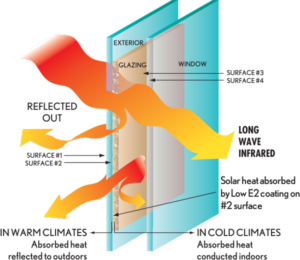Windows provide homes with ventilation, warmth, and light, but they can have negative effects on energy efficiency as well. Over 25% of a home’s energy spending is for air that escapes through inefficient windows, but spending can be reduced with the installation of energy-efficient windows.
In this guide, readers will get some Window and Door Statistics along with information on these windows’ benefits.
Choosing New, Efficient Windows
If your home’s current windows are old and inefficient, it’s likely more cost-effective to replace them than to try to repair them. We offer Marvin Windows, Integrity by Marvin, Infinity by Marvin, and more. It is a well-known fact that energy-efficient windows eventually pay for themselves in the form of lower cooling, heating, and even lighting costs. The good news is, replacement windows have federal energy standards they must meet. While some windows might be more energy efficient than others, you can be confident that all of the windows and doors we offer either meet or exceed those standards. Then, your window choice really becomes a matter of preferred style and operation.
Choosing a Window Design to fit your style.
It’s important to understand which windows and doors are available to your in your area. Many window and door styles are sold regionally, based on the home’s design and the local climate. Before recommending windows for a home, our replacement consultant will use his or her knowledge to determine which type will work best for your area’s unique weather and your home’s location. For instance, we might recommend a different window if you live by Lake Michigan – because of the weather and moisture that often exists near the lakeshore – than if you live in Forest Hills.

Selection Tips
You can find several options when choosing energy-efficient windows. We offer all Marvin Window lines and Windsor Windows and Doors. Each brand has multiple styles, designs and efficiency ratings to consider. We always recommend scheduling a consultation for one of our in-home experts to help you narrow down your options based on your preferences, but here are a few things to discuss when you talk about your options:
All windows and doors are required to be certified by ENERGY STAR’s® window, door and skylight certification program. Which means residential windows have a variety of energy efficiency measurements associated with them that ensure both quality and function for you the homeowner. Two of these measurements are designed to tell consumers about the energy efficiency of that particular window. These measurements are, “U factor,” and “Solar Heat Gain Coefficient,” (SHGC).

According to ENERGY STAR®, If a window qualifies for the ENERGY STAR® label, the National Fenestration Rating Council (NFRC) will have rated the window’s energy efficiency based on U factor and Solar Heat Gain Coefficient.

What do these indicators mean? Well, U factor looks at the rate of heat transfer and shows how well the window is insulated with respect to heat. If a U factor is low, meaning there is little heat transfer, the window has higher quality insulation. For Solar Heat Gain Coefficient, the measurement indicates how well the window blocks heat coming from the sun. Like U factor, if the rate of solar heat allowed in by the window is low, the higher the window performs under those conditions.

For example, since we live in Michigan, a Northern climate, you should look for windows with a U factor of 0.35 or less if you have air conditioning. If you don’t use air conditioning you can purchase a window with a higher U factor such as 0.40 with minimal impact on overall energy efficiency. Similarly, if you want to keep your home cool, choose a window with a high SHGC rating like 0.60. This way, you can leverage the winter sun to offset your home heating bill. But if you prefer a cooler home, choose a lower SHGC rating to keep the heat out.
Operation and Installation
It’s also important to consider how each type of windows operates because some lose less air than others do. The most common types include those listed below.
- Casement windows are hinged at the sides, and they typically have a low air leakage rate.
- Fixed pane windows don’t open, and they’re airtight when installed properly.
- Hopper windows open inward and are hinged on the bottom. Like casement windows, they typically have low leakage rates because the sashes close by pressing on the window frame.
Even the most efficient window must be well-installed to work properly. Installation methods vary depending on window type, home construction, exterior cladding, and other factors. Our professional installers will install all the products we offer according to the manufacturer’s recommendations and they’ll ensure that they’re airtight as well.

Call today to schedule your 100% free consultation. One of our in-home specialists will work with you and answer all your questions to find the perfect replacement window to meet your needs and energy efficiency goals!
